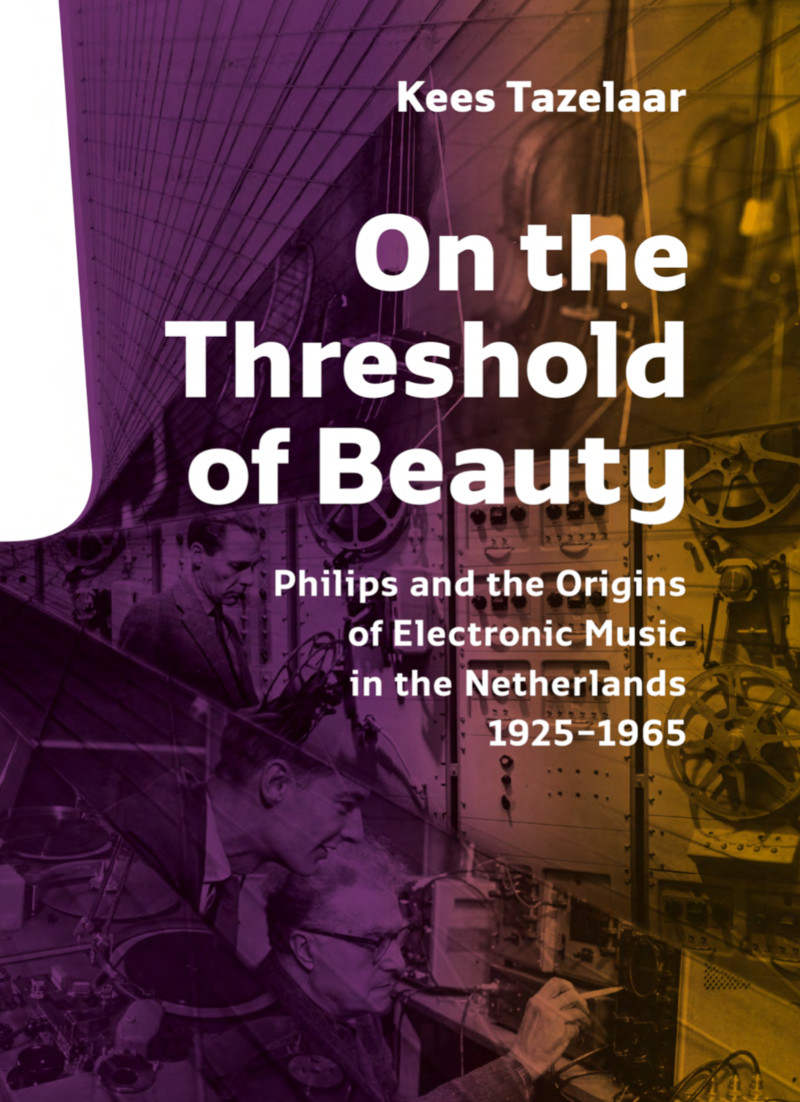Kees Tazelaar: On the Threshold of Beauty: Philips and the Origins of Electronic Music in the Netherlands, 1925-1965 (2013–)
Filed under book | Tags: · composition, electroacoustic music, electronic music, music, music history, musique concrète, netherlands, serialism

“The first studio for electronic music in the Netherlands was not a radio studio — as in so many other countries — it was located at the research laboratory of Philips (also known at NatLab). From 1930 it had been part of the electro-acoustic research program which combined technical, economic, sociologic and musical aspects. The first compositions realized in the Philips studio were thus test-cases. Parallel to this research, other departments of Philips, purely focused at marketing, developed plans for the Philips Pavilion at the World Expo of 1958 at Brussels. Philips planned a demonstration for the general public of the possibilities of sound and light, but through the engagement of Le Corbusier, Iannis Xenakis and Edgar Varèse this project took a strong turn towards the avant-garde. The result, now considered a milestone in the history of electronic music, was in many ways more experimental than the music produced at the Philips research laboratory.
The story of electronic music at the Philips research laboratory and the Philips Pavilion are the first two main strands of the book On the Threshold of Beauty, in which Kees Tazelaar for the first time unravels the course of events, and debunks some of the myths around the Philips Pavilion. A third historical strand concerns the needs of composers, who desired to learn how to compose in the new medium. In 1957 Walter Maas and the CEM set up an electronic studio at the Technical University of Delft for this purpose, which fused with the Philips studio in 1960, and afterwards moved to the University of Utrecht. Tazelaar writes about the works realized at this studio (STEM), as well as about the activities of the ground-breaking German composer Gottfried Michael Koenig who comes to the Netherlands in 1961 and in 1964 takes over the direction of STEM.”
Publisher V2_, Rotterdam, 2013
Revised digital edition, 2020
Open access
ISBN 9789462080652, 9462080658
314 pages
HT Raviv
Reviews: René van Peer (Eindhovens Dagblad, NL, 2013), Hubert Steins (MusikTexte, 2014, DE), Maarten Brandt (OpusKlassiek, NL, 2014), Aurelio Cianciotta (Neural, 2014), Gregory Taylor (Cycling74, 2015).
Book website
Publisher
Publisher (digital edition)
WorldCat
A Bed, a Chair and a Table: Stories from the Poortgebouw (2017)
Filed under book | Tags: · archive, autonomy, community, netherlands, squatting

“A Bed, a Chair and a Table is a publication about the Poortgebouw, a former squat and vibrant living community located in the South of Rotterdam. In this book, oral histories from inside and outside the Poortgebouw are interlaced with material from various institutional and personal archives. By bringing together these tales of resilience, political struggle, frustration and friendship with historical documents, this book brings forward new perspectives about the Poortgebouw’s unique history and its importance in the contemporary city. The starting point of the book was the Autonomous Archive, a local archiving machine built from parts of different computers by the inhabitants of the Poortgebouw and a group of students from XPUB.
A Bed, a Chair and a Table is the fourth ‘Special Issue’ conceptualised, developed and produced by the students from the Experimental Publishing course (XPUB) of the Piet Zwart Institute Media Design Master. It provides a trigger for the reader to further explore the Poortgebouw’s past and to see this building, meet its community, and discuss a potential future amidst all of its complexities. It is a testament to the archive as not the end, but the beginning of a debate.”
Publisher XPUB, Rotterdam, and Meta/Books, Amsterdam, December 2017
ISBN 9789082118247
Special Issue series, 4
Peer Production License
193 pages
Arno van der Hoeven: The Popular Music Heritage of the Dutch Pirates (2012)
Filed under paper | Tags: · 1960s, 1970s, 1980s, cultural heritage, diy, music, netherlands, pirate radio, popular music, radio
“This article explores how cultural identities are negotiated in relation to the heritage of illegal radio in the Netherlands. The term ‘pirate radio’ commonly refers to the offshore radio stations that were broadcasting during the 1960s. These stations introduced commercial radio and popular music genres like beat music, which were not played by public broadcasters at the time. In their wake, land-based pirates began broadcasting for local audiences. This study examines the identities that are constituted by the narrative of pirate radio. Drawing on in-depth interviews with archivists, fans and broadcasters, this article explores the connection between pirate radio, popular music heritage and cultural identity. Moreover, it considers how new technologies such as internet radio provide platforms to engage with this heritage and thus to maintain these local identities. To examine how the memories of pirate radio live on in the present a narrative approach to identity will be used.” (Abstract)
Published in Media, Culture & Society journal, 34(8), pp 927-943
14 pages

